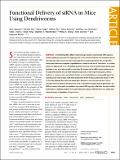Functional Delivery of siRNA in Mice Using Dendriworms
Author(s)
Agrawal, Amit; Min, Dal-Hee; Singh, Neetu; Zhu, Haihao; Birjiniuk, Alona; Harris, Todd J.; Xing, Deyin; Woolfenden, Stephen D.; Sharp, Phillip A.; Charest, Alain; von Maltzhan, Geoffrey; Bhatia, Sangeeta N; ... Show more Show less
DownloadBhatia_Functional Delivery.pdf (475.4Kb)
PUBLISHER_POLICY
Publisher Policy
Article is made available in accordance with the publisher's policy and may be subject to US copyright law. Please refer to the publisher's site for terms of use.
Terms of use
Metadata
Show full item recordAbstract
Small interfering RNAs (siRNAs) mediate cleavage of specific, complementary mRNA sequences and thus regulate gene expression. Not surprisingly, their use for treatment of diseases that are rooted in aberrant gene expression, such as cancer, has become a paradigm that has gained wide interest. Here, we report the development of dendrimer-conjugated magnetofluorescent nanoworms that we call “dendriworms” as a modular platform for siRNA delivery in vivo. This platform maximizes endosomal escape to robustly produce protein target knockdown in vivo, and is tolerated well in mouse brain. We demonstrate that siRNA-carrying dendriworms can be readily internalized by cells and enable endosomal escape across a wide range of loading doses, whereas dendrimers or nanoworms alone are inefficient. Further, we show that dendriworms carrying siRNA against the epidermal growth factor receptor (EGFR) reduce protein levels of EGFR in human glioblastoma cells by 70−80%, 2.5-fold more efficiently than commercial cationic lipids. Dendriworms were well-tolerated after 7-days of convection-enhanced delivery to the mouse brain and in an EGFR-driven transgenic model of glioblastoma, anti- EGFR dendriworms led to specific and significant suppression of EGFR expression. Collectively, these data establish dendriworms as a multimodal platform that enables fluorescent tracking of siRNA delivery in vivo, cellular entry, endosomal escape, and knockdown of target proteins.
Date issued
2009-09Department
Whitaker College of Health Sciences and Technology; Harvard University--MIT Division of Health Sciences and Technology; Massachusetts Institute of Technology. Department of Biology; Massachusetts Institute of Technology. Department of Electrical Engineering and Computer ScienceJournal
ACS nano
Publisher
American Chemical Society
Citation
Agrawal, Amit et al. “Functional Delivery of siRNA in Mice Using Dendriworms.” ACS Nano 3.9 (2009) : 2495-2504.© 2009 American Chemical Society.
Version: Final published version
ISSN
1936-0851
1936-086X